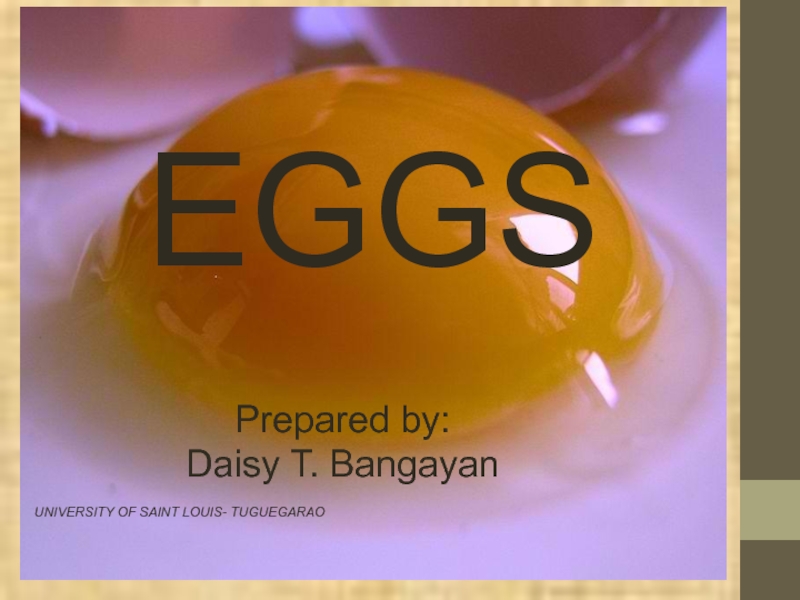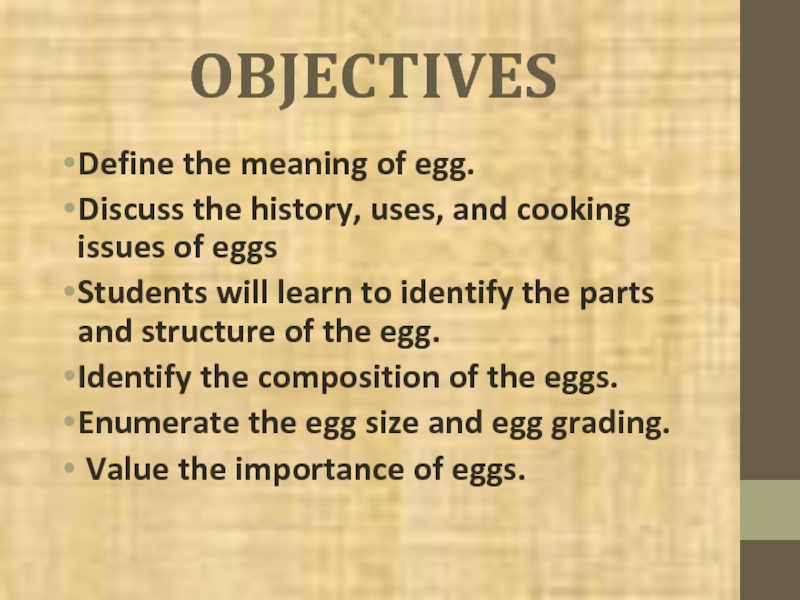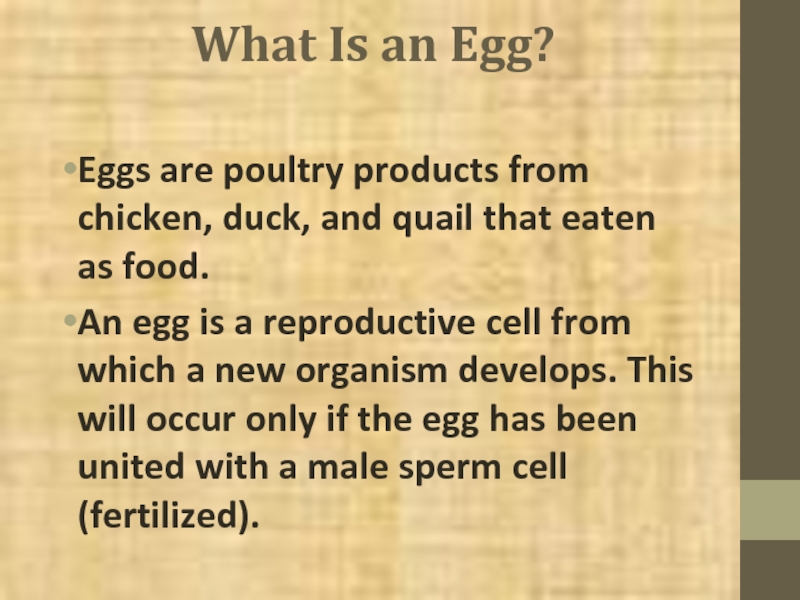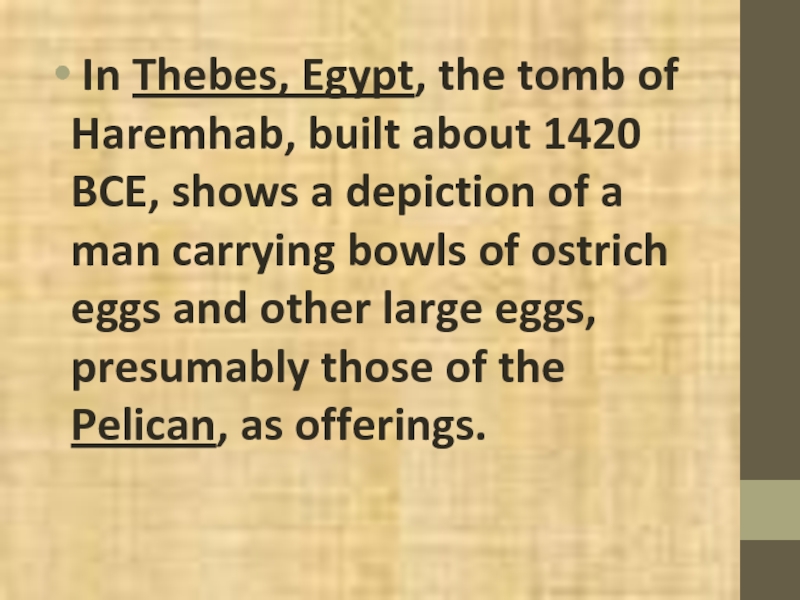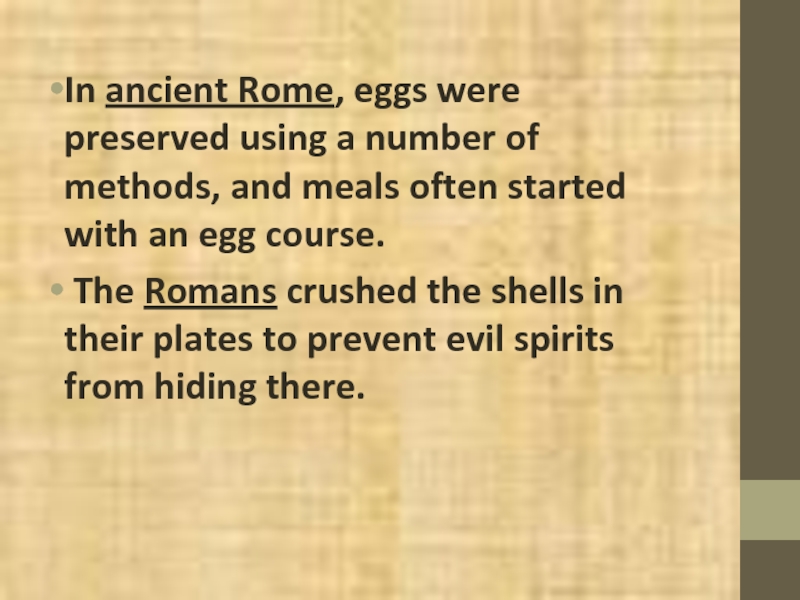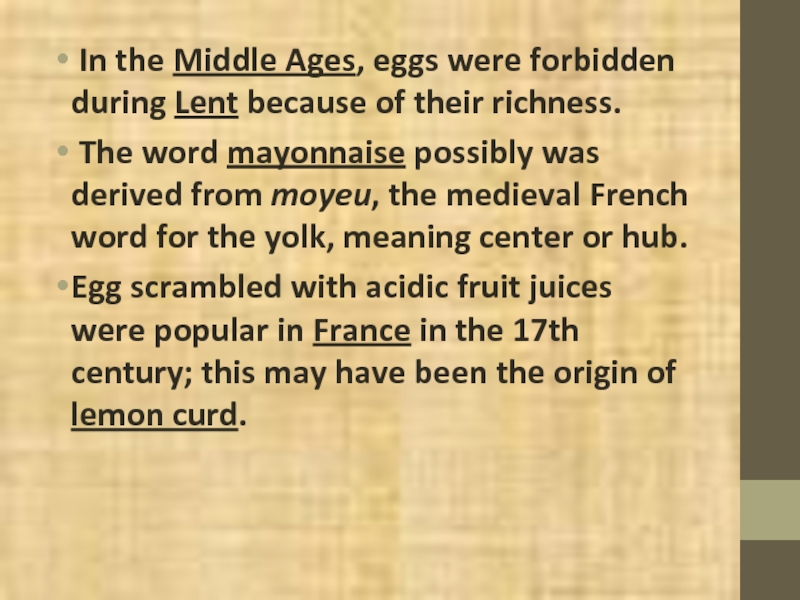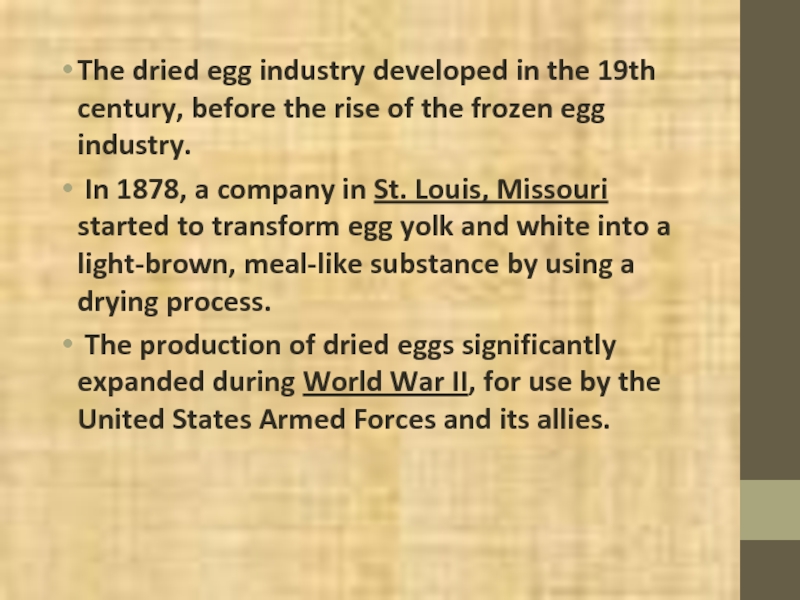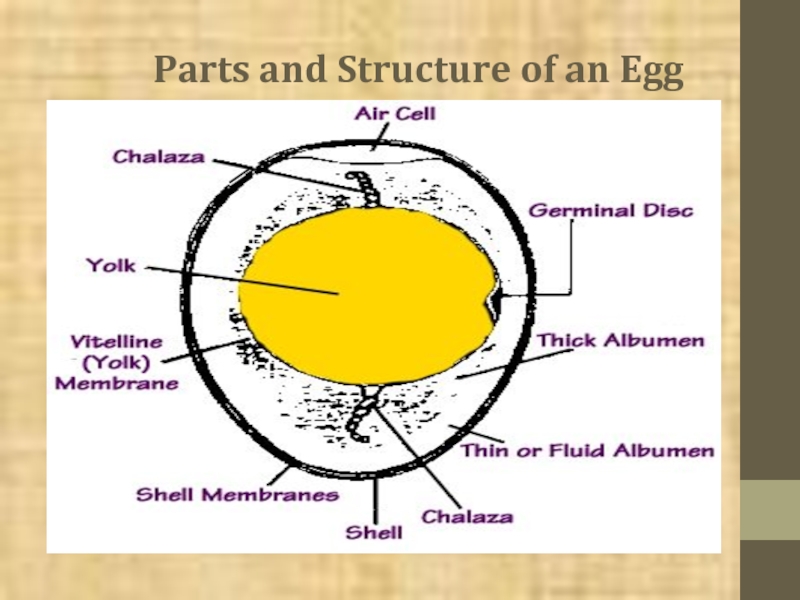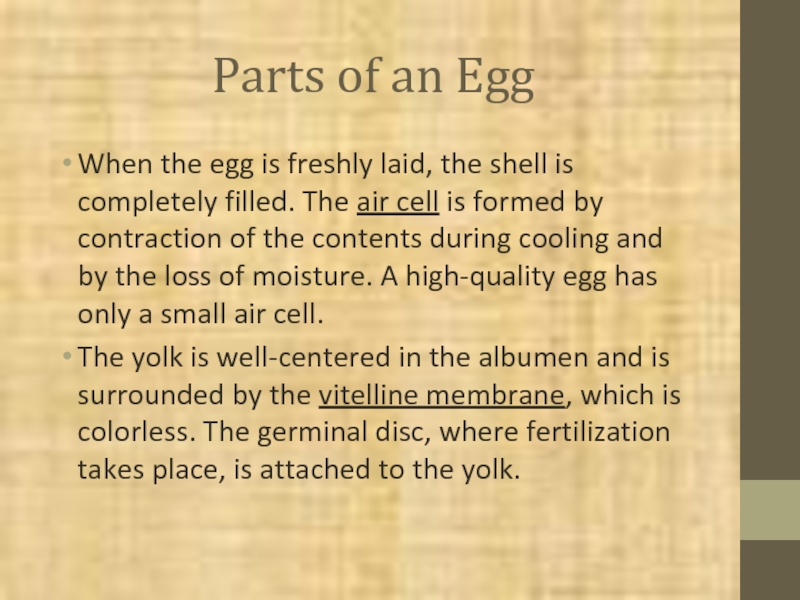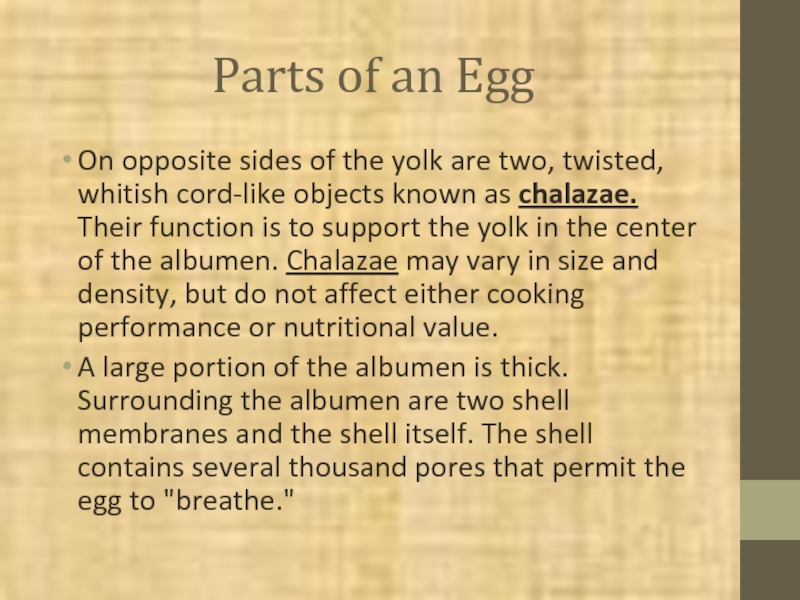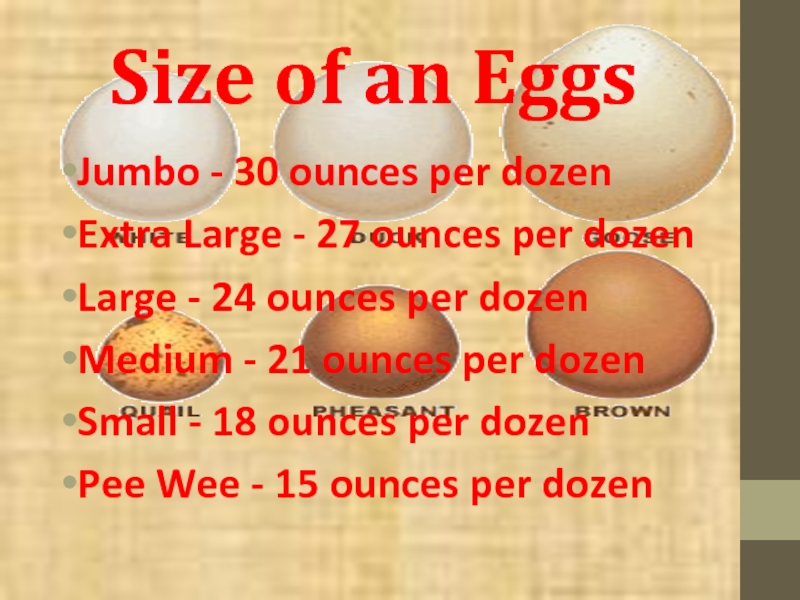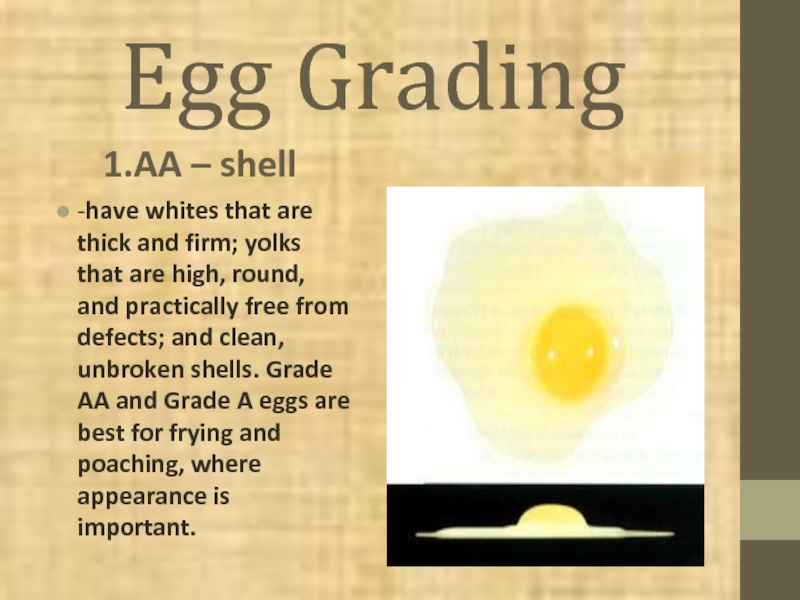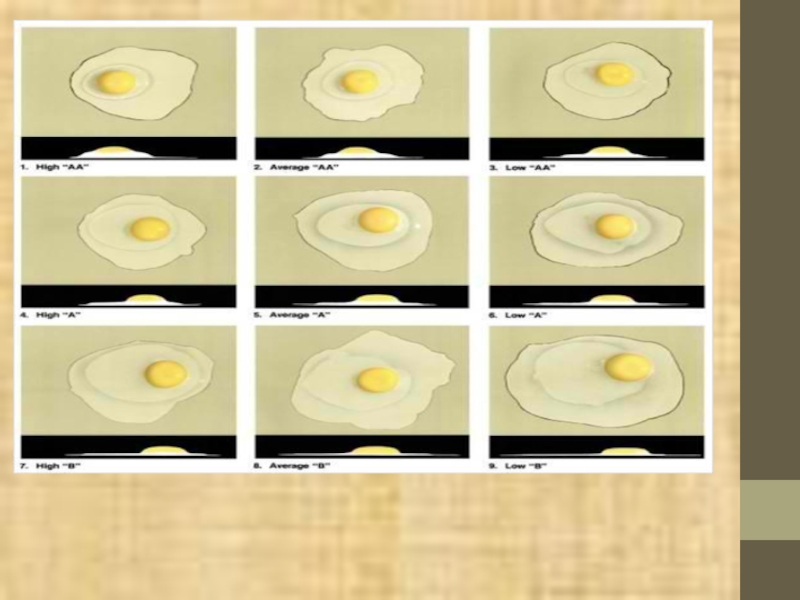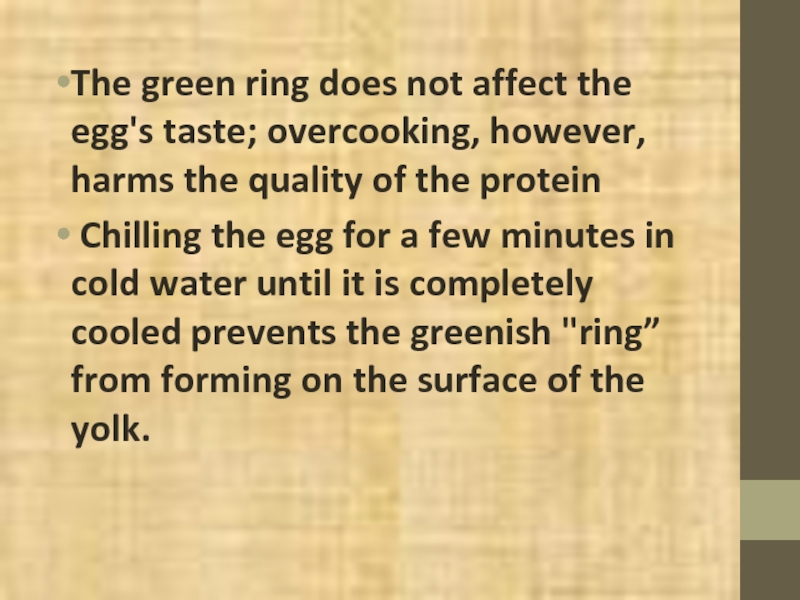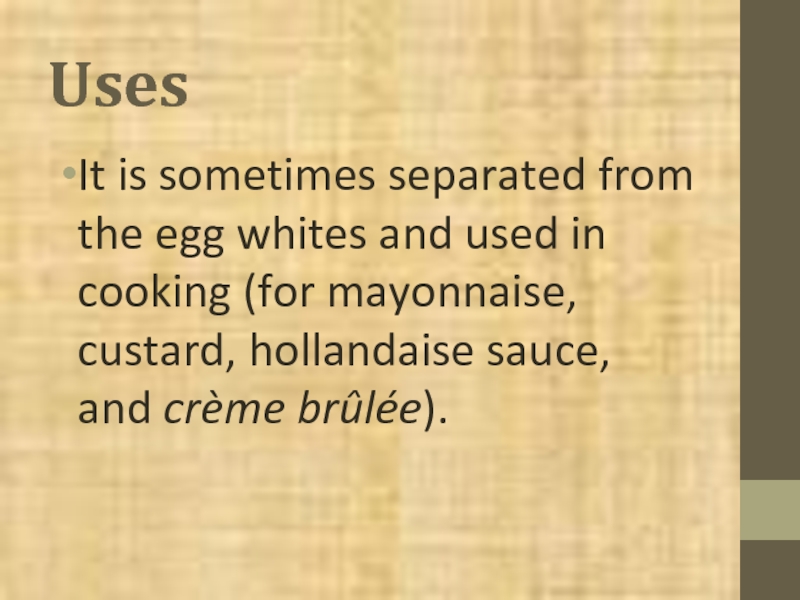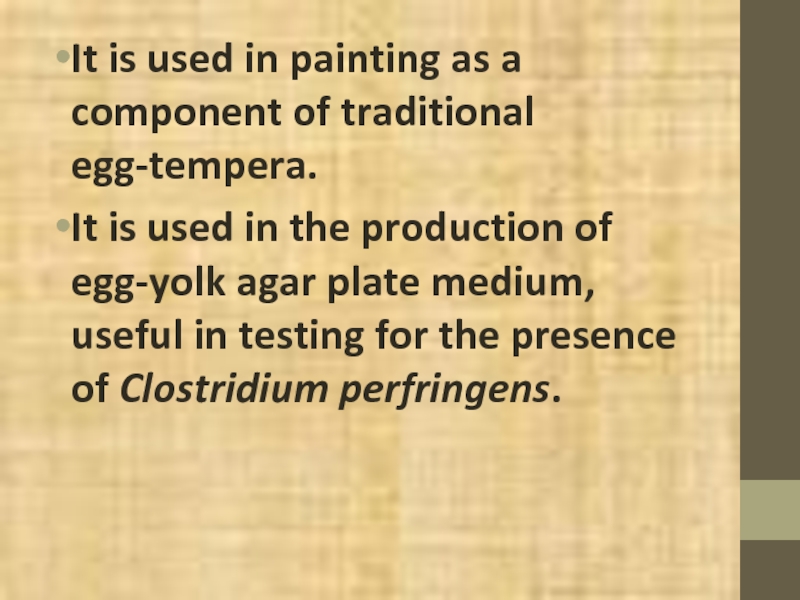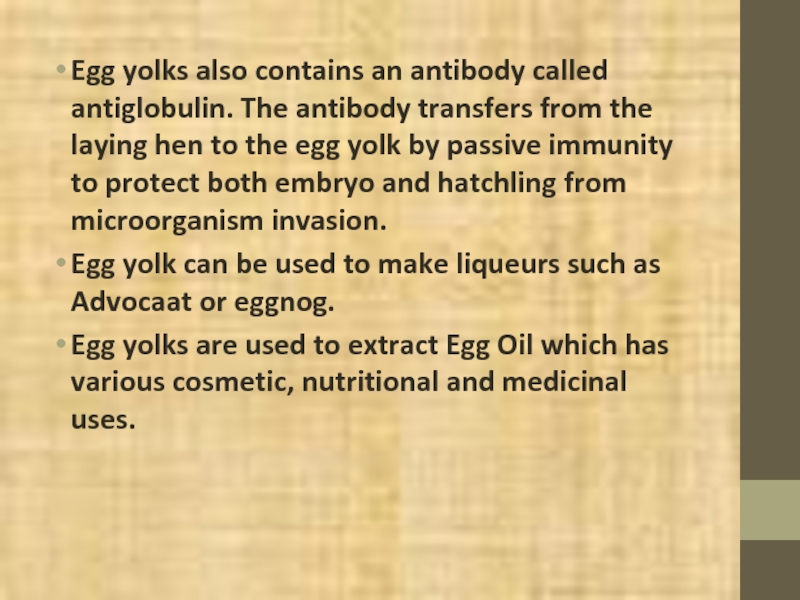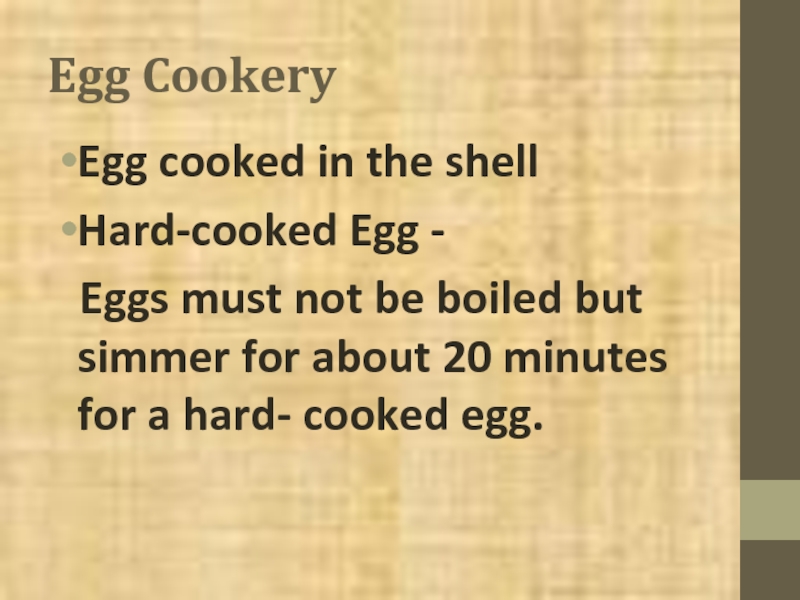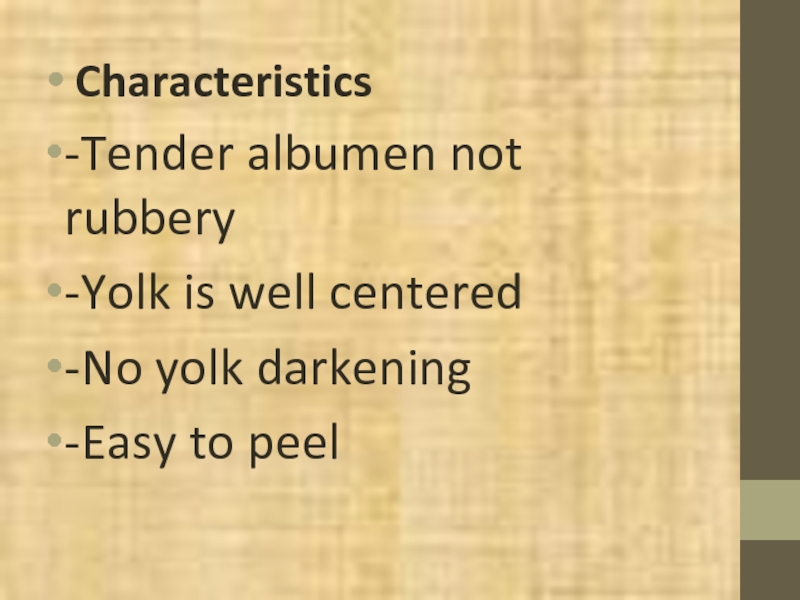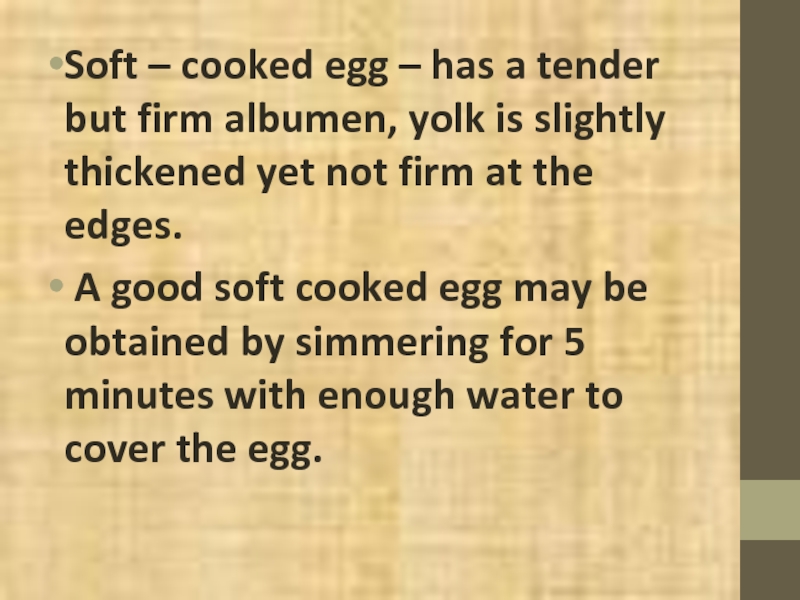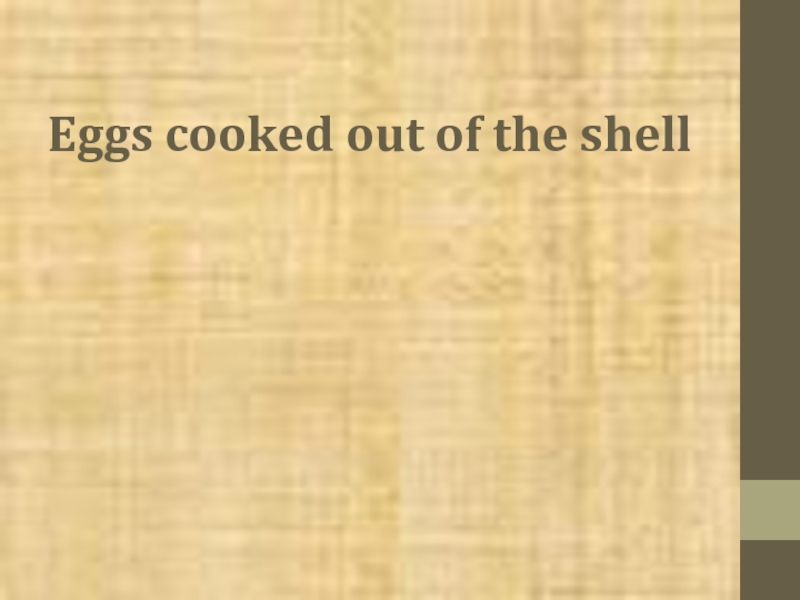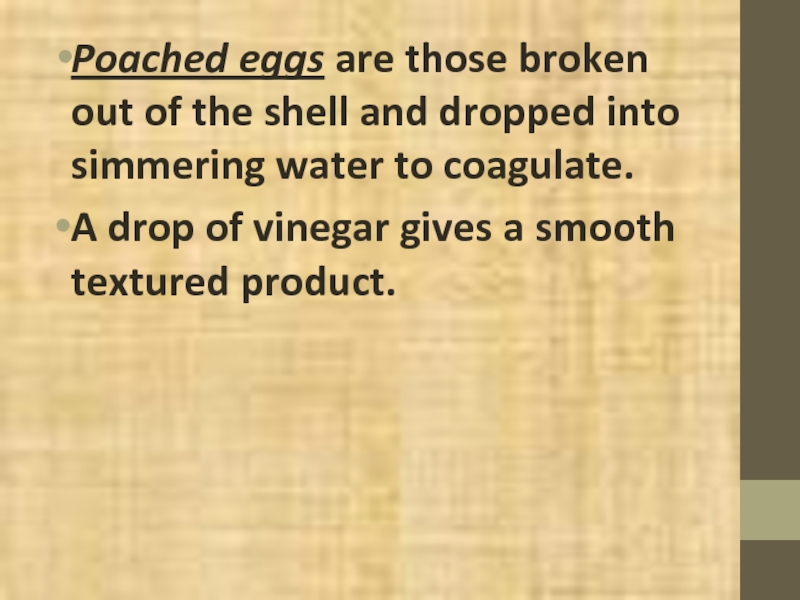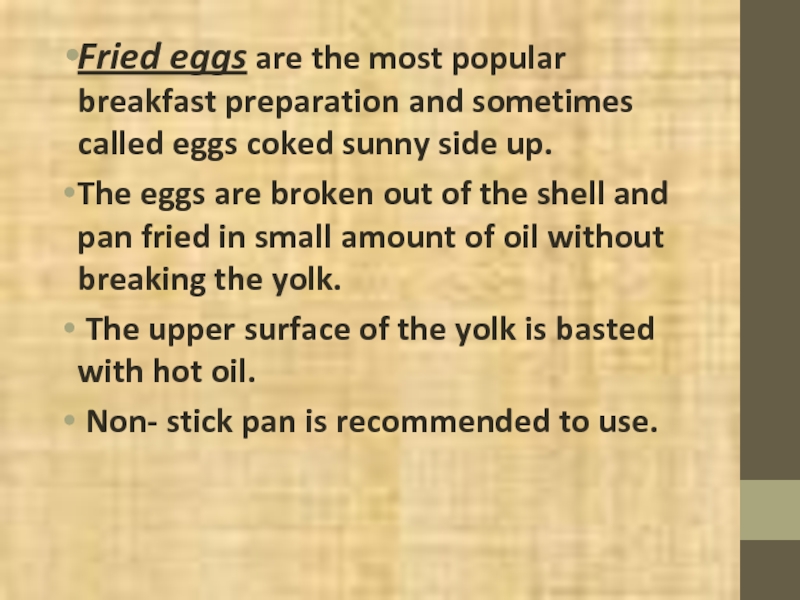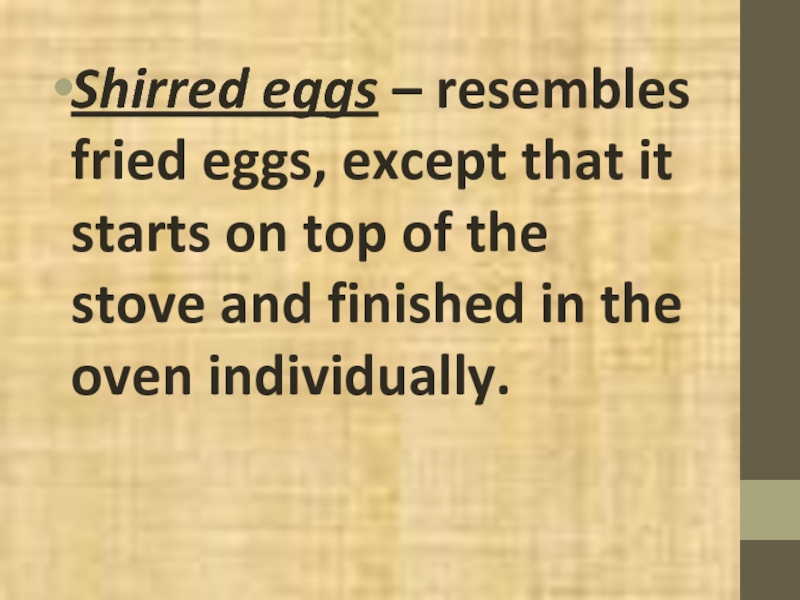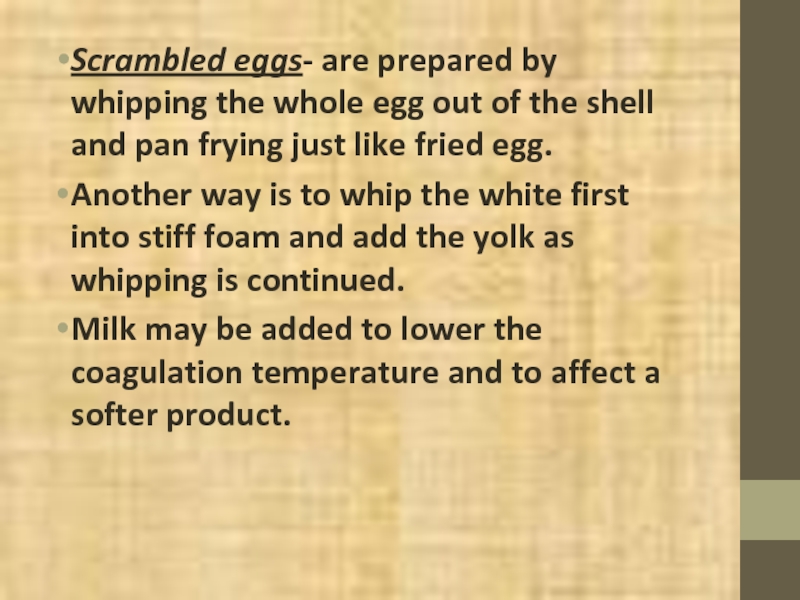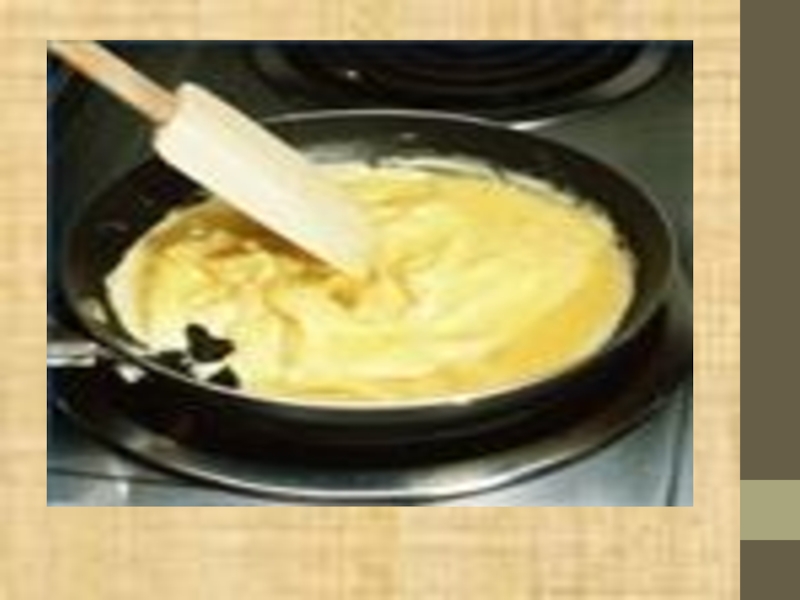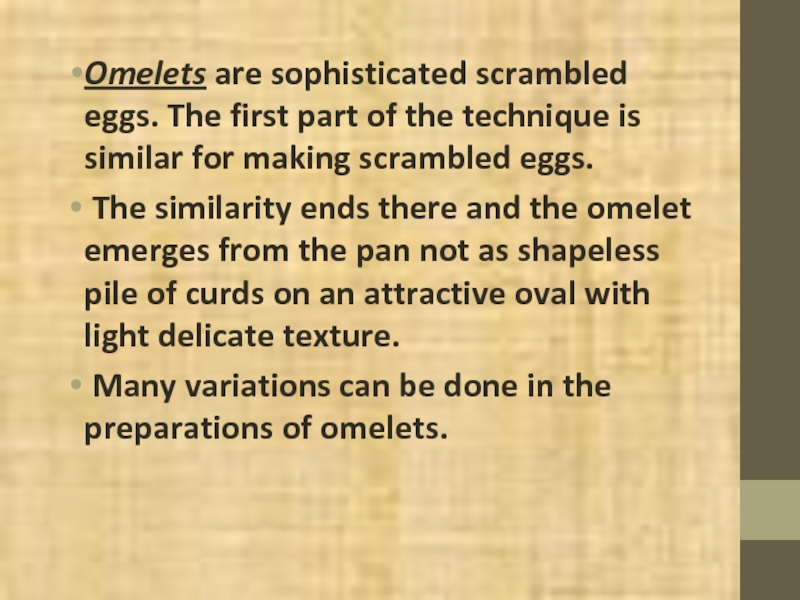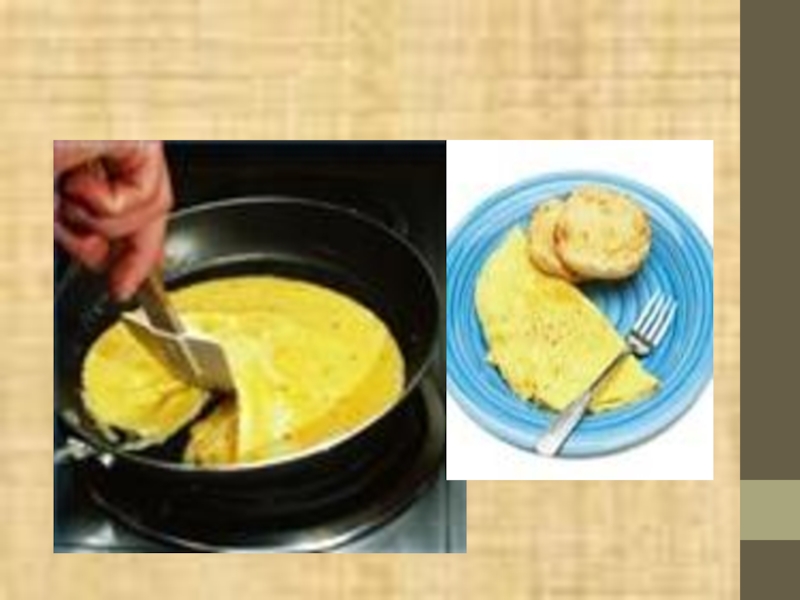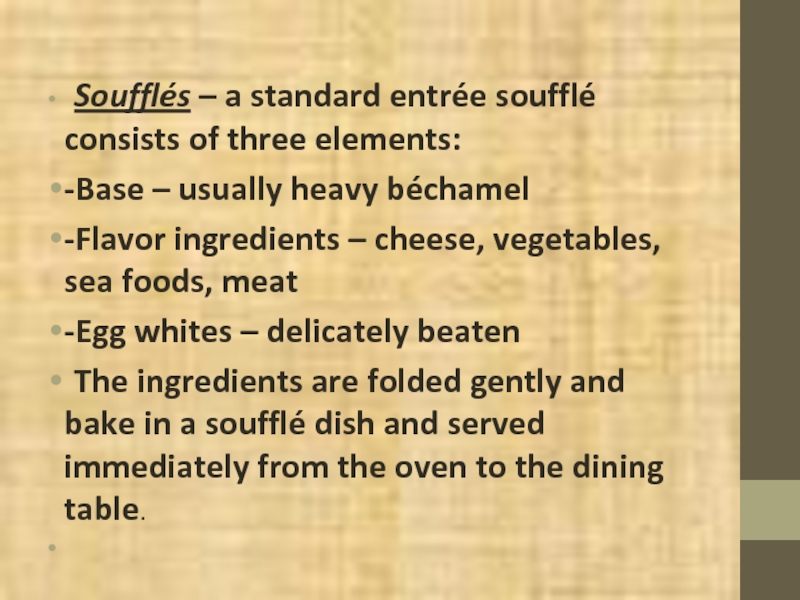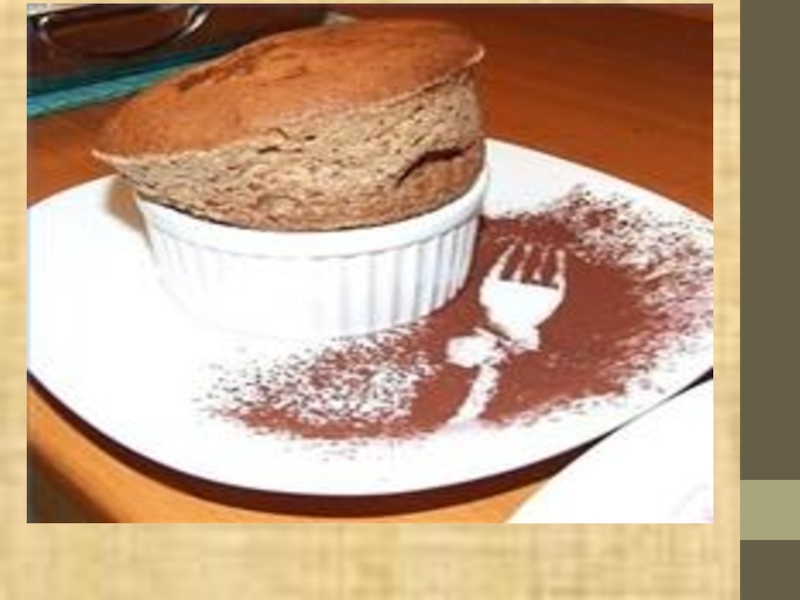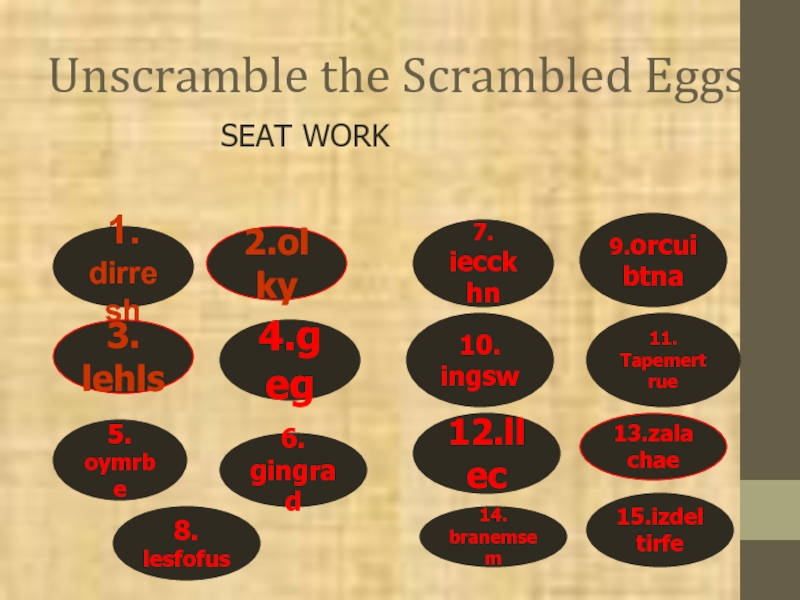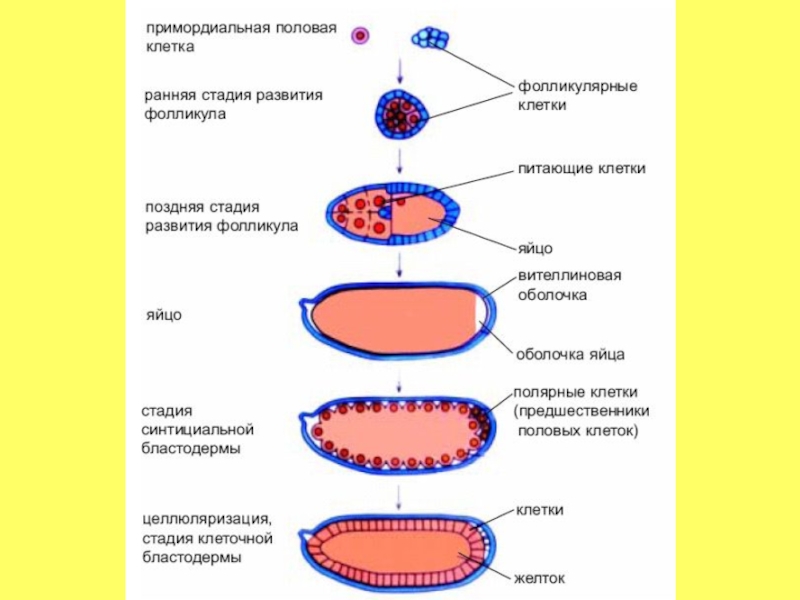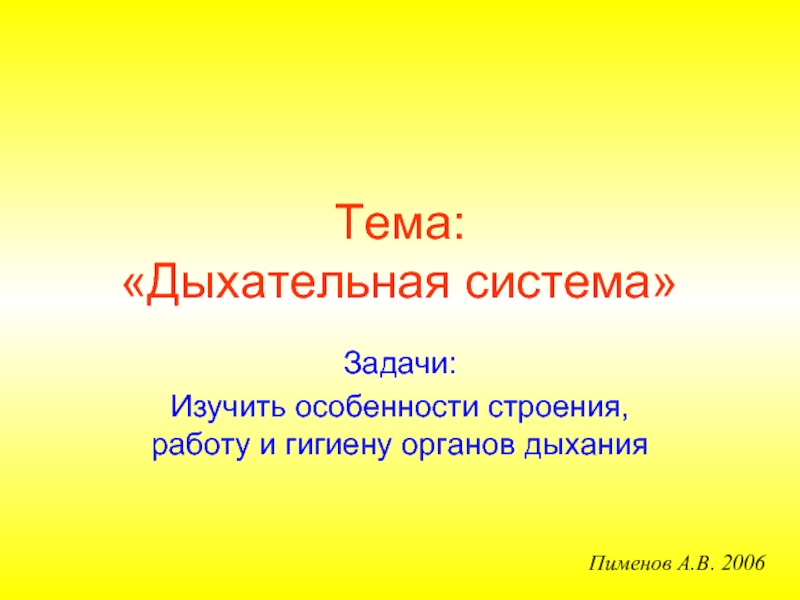- Главная
- Разное
- Дизайн
- Бизнес и предпринимательство
- Аналитика
- Образование
- Развлечения
- Красота и здоровье
- Финансы
- Государство
- Путешествия
- Спорт
- Недвижимость
- Армия
- Графика
- Культурология
- Еда и кулинария
- Лингвистика
- Английский язык
- Астрономия
- Алгебра
- Биология
- География
- Детские презентации
- Информатика
- История
- Литература
- Маркетинг
- Математика
- Медицина
- Менеджмент
- Музыка
- МХК
- Немецкий язык
- ОБЖ
- Обществознание
- Окружающий мир
- Педагогика
- Русский язык
- Технология
- Физика
- Философия
- Химия
- Шаблоны, картинки для презентаций
- Экология
- Экономика
- Юриспруденция
EGGS презентация
Содержание
- 1. EGGS
- 2. OBJECTIVES Define the meaning of egg. Discuss
- 3. What Is an Egg? Eggs are
- 5. History Bird eggs have been
- 6. The chicken was probably domesticated for its
- 7. In Thebes, Egypt, the tomb of
- 8. In ancient Rome, eggs were preserved using
- 9. In the Middle Ages, eggs were
- 10. The dried egg industry developed in the
- 11. In 1911, the egg carton was invented
- 12. Parts and Structure of an Egg
- 13. Parts and Structure of an Egg 1.
- 14. Parts of an Egg 3. Shell membrane
- 15. Parts of an Egg When the egg
- 16. Parts of an Egg On opposite sides
- 17. Size of an Eggs Jumbo - 30
- 18. Egg Grading 1.AA – shell -have whites
- 19. 2. A-shell-
- 20. 3. B-shell- clean to slightly stained, air
- 22. Cooking Issues Egg white coagulates, or solidifies,
- 23. If a boiled egg is overcooked, a
- 24. The green ring does not affect the
- 25. Cooking also increases the risk of atherosclerosis
- 26. Uses It is sometimes separated
- 27. It is used in painting as a
- 28. Egg yolks also contains an antibody called
- 29. Egg Cookery Egg cooked in the shell
- 30. The cooked egg should be immersed in
- 31. Characteristics -Tender albumen not rubbery -Yolk
- 32. Rules to follow in the hard
- 33. Soft – cooked egg – has a
- 34. Eggs cooked out of the shell
- 35. Poached eggs are those broken out of
- 36. Fried eggs are the most popular breakfast
- 37. Shirred eggs – resembles fried eggs, except
- 38. Scrambled eggs- are prepared by whipping the
- 40. Omelets are sophisticated scrambled eggs. The first
- 42. Soufflés – a standard entrée soufflé
- 44. Unscramble the Scrambled Eggs
- 45. THANK YOU AND HAVE A NICE DAY!
Слайд 2OBJECTIVES
Define the meaning of egg.
Discuss the history, uses, and cooking issues
of eggs
Students will learn to identify the parts and structure of the egg.
Identify the composition of the eggs.
Enumerate the egg size and egg grading.
Value the importance of eggs.
Students will learn to identify the parts and structure of the egg.
Identify the composition of the eggs.
Enumerate the egg size and egg grading.
Value the importance of eggs.
Слайд 3What Is an Egg?
Eggs are poultry products from chicken, duck, and
quail that eaten as food.
An egg is a reproductive cell from which a new organism develops. This will occur only if the egg has been united with a male sperm cell (fertilized).
An egg is a reproductive cell from which a new organism develops. This will occur only if the egg has been united with a male sperm cell (fertilized).
Слайд 5
History
Bird eggs have been valuable foodstuffs since prehistory, in both hunting
societies and more recent cultures where birds were domesticated.
Слайд 6The chicken was probably domesticated for its eggs from jungle fowl
native to tropical and subtropical Southeast Asia and India before 7500 BCE. Chickens were brought to Sumer and Egypt by 1500 BCE, and arrived in Greece around 800 BCE, where the quail had been the primary source of eggs.
Слайд 7 In Thebes, Egypt, the tomb of Haremhab, built about 1420
BCE, shows a depiction of a man carrying bowls of ostrich eggs and other large eggs, presumably those of the Pelican, as offerings.
Слайд 8In ancient Rome, eggs were preserved using a number of methods,
and meals often started with an egg course.
The Romans crushed the shells in their plates to prevent evil spirits from hiding there.
The Romans crushed the shells in their plates to prevent evil spirits from hiding there.
Слайд 9 In the Middle Ages, eggs were forbidden during Lent because
of their richness.
The word mayonnaise possibly was derived from moyeu, the medieval French word for the yolk, meaning center or hub.
Egg scrambled with acidic fruit juices were popular in France in the 17th century; this may have been the origin of lemon curd.
The word mayonnaise possibly was derived from moyeu, the medieval French word for the yolk, meaning center or hub.
Egg scrambled with acidic fruit juices were popular in France in the 17th century; this may have been the origin of lemon curd.
Слайд 10The dried egg industry developed in the 19th century, before the
rise of the frozen egg industry.
In 1878, a company in St. Louis, Missouri started to transform egg yolk and white into a light-brown, meal-like substance by using a drying process.
The production of dried eggs significantly expanded during World War II, for use by the United States Armed Forces and its allies.
In 1878, a company in St. Louis, Missouri started to transform egg yolk and white into a light-brown, meal-like substance by using a drying process.
The production of dried eggs significantly expanded during World War II, for use by the United States Armed Forces and its allies.
Слайд 11In 1911, the egg carton was invented by Joseph Coyle in
Smithers, British Columbia, to solve a dispute about broken eggs between a farmer in Bulkley Valley and the owner of the Aldermere Hotel.
Early egg cartons were made of paper.
Early egg cartons were made of paper.
Слайд 13Parts and Structure of an Egg
1. Yolk
- This is the yellow
or orange portion found in the center of the egg.
- the yolk is encased in a colorless membrane called the vitelline membrane
2. White
- this also called the albumen
- the yolk is suspended in it by two yolk cords or chalazae ( Kah-lay-za)
- the yolk is encased in a colorless membrane called the vitelline membrane
2. White
- this also called the albumen
- the yolk is suspended in it by two yolk cords or chalazae ( Kah-lay-za)
Слайд 14Parts of an Egg
3. Shell membrane
- there are two membranes, the
inner and outer which are readily seen when peeling hard cooked eggs.
4. Shell
- this is made up mainly of calcium carbonate.
4. Shell
- this is made up mainly of calcium carbonate.
Слайд 15Parts of an Egg
When the egg is freshly laid, the shell
is completely filled. The air cell is formed by contraction of the contents during cooling and by the loss of moisture. A high-quality egg has only a small air cell.
The yolk is well-centered in the albumen and is surrounded by the vitelline membrane, which is colorless. The germinal disc, where fertilization takes place, is attached to the yolk.
The yolk is well-centered in the albumen and is surrounded by the vitelline membrane, which is colorless. The germinal disc, where fertilization takes place, is attached to the yolk.
Слайд 16Parts of an Egg
On opposite sides of the yolk are two,
twisted, whitish cord-like objects known as chalazae. Their function is to support the yolk in the center of the albumen. Chalazae may vary in size and density, but do not affect either cooking performance or nutritional value.
A large portion of the albumen is thick. Surrounding the albumen are two shell membranes and the shell itself. The shell contains several thousand pores that permit the egg to "breathe."
A large portion of the albumen is thick. Surrounding the albumen are two shell membranes and the shell itself. The shell contains several thousand pores that permit the egg to "breathe."
Слайд 17Size of an Eggs
Jumbo - 30 ounces per dozen
Extra Large -
27 ounces per dozen
Large - 24 ounces per dozen
Medium - 21 ounces per dozen
Small - 18 ounces per dozen
Pee Wee - 15 ounces per dozen
Large - 24 ounces per dozen
Medium - 21 ounces per dozen
Small - 18 ounces per dozen
Pee Wee - 15 ounces per dozen
Слайд 18Egg Grading
1.AA – shell
-have whites that are thick and firm; yolks
that are high, round, and practically free from defects; and clean, unbroken shells. Grade AA and Grade A eggs are best for frying and poaching, where appearance is important.
Слайд 19
2. A-shell-
eggs have characteristics of Grade AA eggs except the
whites are "reasonably" firm. This is the quality most often sold in stores.
Слайд 203. B-shell- clean to slightly stained, air cell over 3/16" deep,
white-weaker and watery.
eggs have whites that may be thinner and yolks that may be wider and flatter than eggs of higher grades. The shells must be unbroken, but may show slight stains. This quality is seldom found in retail stores because they are usually used to make liquid, frozen, and dried egg products, as well as other egg-containing products.
eggs have whites that may be thinner and yolks that may be wider and flatter than eggs of higher grades. The shells must be unbroken, but may show slight stains. This quality is seldom found in retail stores because they are usually used to make liquid, frozen, and dried egg products, as well as other egg-containing products.
Слайд 22Cooking Issues
Egg white coagulates, or solidifies, when it reaches temperatures between
144 °F and 149 °F (62.2 °C-65 °C).
Egg yolk coagulates at slightly higher temperatures, between 149 °F and 158 °F (65 °C-70 °C).
Egg yolk coagulates at slightly higher temperatures, between 149 °F and 158 °F (65 °C-70 °C).
Слайд 23If a boiled egg is overcooked, a greenish ring sometimes appears
around egg yolk due to the iron and sulfur compounds in the egg.
It can also occur when there is an abundance of iron in the cooking water.
It can also occur when there is an abundance of iron in the cooking water.
Слайд 24The green ring does not affect the egg's taste; overcooking, however,
harms the quality of the protein
Chilling the egg for a few minutes in cold water until it is completely cooled prevents the greenish "ring” from forming on the surface of the yolk.
Chilling the egg for a few minutes in cold water until it is completely cooled prevents the greenish "ring” from forming on the surface of the yolk.
Слайд 25Cooking also increases the risk of atherosclerosis due to increased oxidization
of the cholesterol contained in the egg yolk.
Слайд 26
Uses
It is sometimes separated from the egg whites and used in
cooking (for mayonnaise, custard, hollandaise sauce, and crème brûlée).
Слайд 27It is used in painting as a component of traditional egg-tempera.
It
is used in the production of egg-yolk agar plate medium, useful in testing for the presence of Clostridium perfringens.
Слайд 28Egg yolks also contains an antibody called antiglobulin. The antibody transfers
from the laying hen to the egg yolk by passive immunity to protect both embryo and hatchling from microorganism invasion.
Egg yolk can be used to make liqueurs such as Advocaat or eggnog.
Egg yolks are used to extract Egg Oil which has various cosmetic, nutritional and medicinal uses.
Egg yolk can be used to make liqueurs such as Advocaat or eggnog.
Egg yolks are used to extract Egg Oil which has various cosmetic, nutritional and medicinal uses.
Слайд 29Egg Cookery
Egg cooked in the shell
Hard-cooked Egg -
Eggs
must not be boiled but simmer for about 20 minutes for a hard- cooked egg.
Слайд 30The cooked egg should be immersed in cold water and flushed
in running water immediately after cooking to avoid darkening of the yolk.
The greenish coloration of the yolk is due to the formation of iron sulfide during cooking. Iron comes from the yolk and the sulfide from the white.
The greenish coloration of the yolk is due to the formation of iron sulfide during cooking. Iron comes from the yolk and the sulfide from the white.
Слайд 31 Characteristics
-Tender albumen not rubbery
-Yolk is well centered
-No yolk darkening
-Easy to
peel
Слайд 32
Rules to follow in the hard cooking of eggs
-Use fresh eggs
-Allow to stand overnight at room temperature
-Simmer for 20 minutes
-Put the egg in when water is about to boil to have less cracks.
-Cool immediately in running water.
-Simmer for 20 minutes
-Put the egg in when water is about to boil to have less cracks.
-Cool immediately in running water.
Слайд 33Soft – cooked egg – has a tender but firm albumen,
yolk is slightly thickened yet not firm at the edges.
A good soft cooked egg may be obtained by simmering for 5 minutes with enough water to cover the egg.
A good soft cooked egg may be obtained by simmering for 5 minutes with enough water to cover the egg.
Слайд 35Poached eggs are those broken out of the shell and dropped
into simmering water to coagulate.
A drop of vinegar gives a smooth textured product.
A drop of vinegar gives a smooth textured product.
Слайд 36Fried eggs are the most popular breakfast preparation and sometimes called
eggs coked sunny side up.
The eggs are broken out of the shell and pan fried in small amount of oil without breaking the yolk.
The upper surface of the yolk is basted with hot oil.
Non- stick pan is recommended to use.
The eggs are broken out of the shell and pan fried in small amount of oil without breaking the yolk.
The upper surface of the yolk is basted with hot oil.
Non- stick pan is recommended to use.
Слайд 37Shirred eggs – resembles fried eggs, except that it starts on
top of the stove and finished in the oven individually.
Слайд 38Scrambled eggs- are prepared by whipping the whole egg out of
the shell and pan frying just like fried egg.
Another way is to whip the white first into stiff foam and add the yolk as whipping is continued.
Milk may be added to lower the coagulation temperature and to affect a softer product.
Another way is to whip the white first into stiff foam and add the yolk as whipping is continued.
Milk may be added to lower the coagulation temperature and to affect a softer product.
Слайд 40Omelets are sophisticated scrambled eggs. The first part of the technique
is similar for making scrambled eggs.
The similarity ends there and the omelet emerges from the pan not as shapeless pile of curds on an attractive oval with light delicate texture.
Many variations can be done in the preparations of omelets.
The similarity ends there and the omelet emerges from the pan not as shapeless pile of curds on an attractive oval with light delicate texture.
Many variations can be done in the preparations of omelets.
Слайд 42
Soufflés – a standard entrée soufflé consists of three elements:
-Base –
usually heavy béchamel
-Flavor ingredients – cheese, vegetables, sea foods, meat
-Egg whites – delicately beaten
The ingredients are folded gently and bake in a soufflé dish and served immediately from the oven to the dining table.
-Flavor ingredients – cheese, vegetables, sea foods, meat
-Egg whites – delicately beaten
The ingredients are folded gently and bake in a soufflé dish and served immediately from the oven to the dining table.
Слайд 44Unscramble the Scrambled Eggs
1. dirresh
3. lehls
4.geg
5. oymrbe
6. gingrad
7. iecckhn
9.orcuibtna
10. ingsw
11.
Tapemertrue
12.llec
13.zalachae
2.olky
14. branemsem
15.izdeltirfe
SEAT WORK
8.
lesfofus
